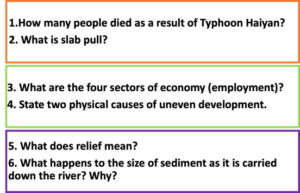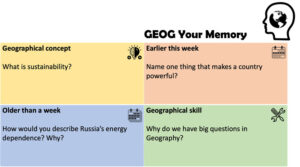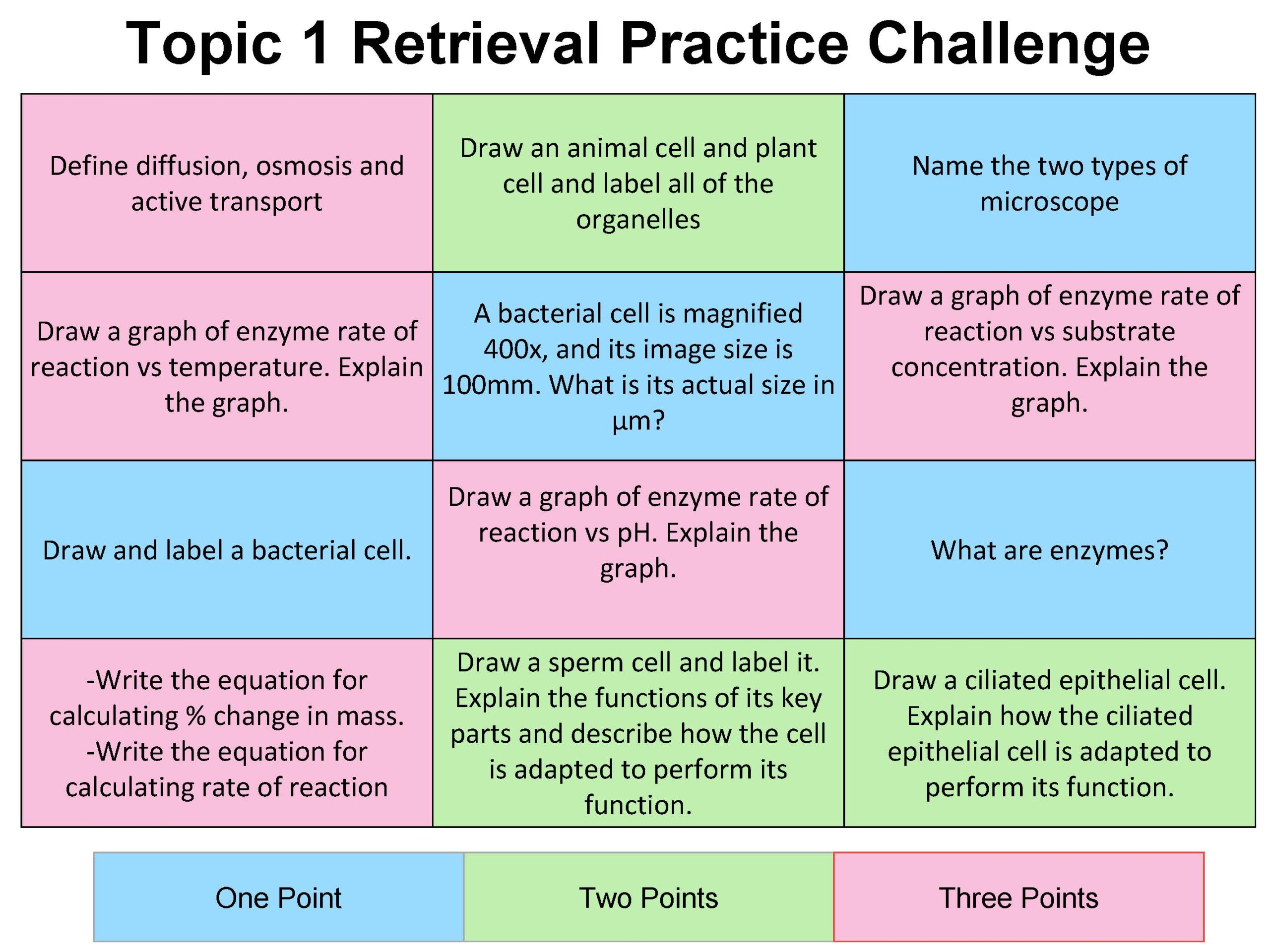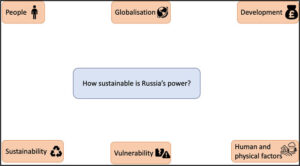In my previous three blogs, I have addressed the power of retrieval practice, using retrieval alongside spaced practice and how to use retrieval to self-regulate learning. Here, I am going to highlight some of the key strategies I use in my lessons. With all of these strategies it is critical that students are given feedback and the opportunity to review and mark their answers so that they know their strengths and weaknesses. It is also important to recognise that you may not see immediate impact; retrieval practice often takes a while to embed, so stick with it. I promise it will work in the long-term!
The six questions
My favourite and most used strategy is straightforward: the students are given six questions to answer, two from earlier that week, two from a previous topic, and two from a topic learnt at the start of the year (example below). This is an incredibly effective strategy as in this way students are practising both spaced and retrieval practice at the same time, and a range of questioning styles can be used to address both knowledge recall and deeper thinking. In addition, if the questions are selected carefully, they can both activate prior knowledge for the lesson ahead while also encouraging schema building between different topics. I use this strategy at the start of almost all of my KS4 lessons.
We use a similar technique in our KS3 lessons, using the acronym ‘GEOG your memory’, where G stands for Geographical concept (a question linking to a key concept in Geography), E stands for earlier this week, O stands for older than a week and G stands for Geographical skill (example below). In this way we are able to focus our retrieval on knowledge that underpins our Geography curriculum, building students’ memory and schema.
Odd one out
Another effective retrieval strategy is tasking students with identifying the odd one out and explain their reasoning (example below). Once again, this strategy lends itself to being flexible; the factors students are reviewing can be key terms, concepts, events etc. The important part of this strategy is the explanation, which tests the students’ understanding – and helps to unpick common misconceptions – while also helping them to build links between different concepts.
| A | B | C | Explanation |
| Whitechapel murders | Jack the Ripper | Hue and Cry | |
| The Munich Putsch | The Treaty of Versailles | Hitler | |
| The Derek Bentley Case | Sir Robert Peel | Metropolitan Police | |
| 1929 | Hyperinflation in Germany | The Wall Street Crash | |
| Communism | Capitalism | The USSR (Russia) |
|
| 1939 | 1605 | The Gunpowder Plot |
|
| Trial by Ordeal | Trial by hot water | Pentonville Prison |
|
Mind-map with two colours
This strategy is incredibly effective and requires minimum planning. Students make a mind-map of everything they can remember about a topic or concept or character on a blank piece of paper using one colour. The class then feeds back and the teacher creates a mind-map on the board using the students’ ideas. As this is happening, the students use a different coloured pen to add to their mind-map any ideas they had forgotten which helps them target their revision. This can then be repeated a few weeks later and students will be able to see the progress of their long-term memory.
Retrieval grids
Retrieval grids are used in a variety of different ways and can be another effective way of using both spaced and retrieval practice.
The most commonly used retrieval practice grid is a challenge grid, in which the retrieval grid contains several boxes of different colours (example below). Each box contains a question and the colour relates to the length of time since the students first learned it; these colours relate to a point-based system in which the questions from longest ago are worth more points. This enables teachers to introduce a competitive element to the retrieval practice, which may provide motivation for students in certain contexts.
Retrieval quilts/concept maps
This retrieval strategy encourages students to make links and connections within and between topics. This strategy is particularly effective as this helps students to build their schema and make links independently. As with other strategies, this can be adapted according to the context of the students and the subject. For example, you can give students a grid with key terms and concepts and they can roll the dice in order to determine which two boxes they should be making links between. In Geography, we use this to help students to practise their 4 figure grid references, giving them co-ordinates to identify the key terms or factors between which they are making links (example below).
In our Key Stage 3 curriculum, our students answer fertile questions at the end of each unit to help them to draw their learning from the topic together. We also have six threshold concepts that underpin our curriculum across all key stages. We use these concept maps to help students to develop links between these concepts and the fertile question as students progress through the unit, as well as a retrieval tool at the end of the unit before they answer their fertile question (example below). This has proven to be very effective in developing and strengthening students’ long-term memories.
Mini-whiteboards
Arguably the simplest strategy is the mini-whiteboard. This strategy ensures that all learners are participating and gives both the teacher and the students instant feedback. Teachers can easily see which students are and aren’t participating, as well as seeing which answers students are getting right and wrong; equally, students know the answer instantly without having to mark their work. Mini-whiteboards can also develop student confidence. This strategy also provides the teacher with the opportunity to ask follow-up questions such as “why do you think this is the correct answer?” and “can you explain how your answer links to…?”
This is just a suggestion of tried and tested strategies I use regularly in my lessons and that have had effective results. There are many other strategies and variations on these approaches available, and the best way to work out which work for you and your students is to give them ago. My final piece of advice is to use these techniques to get students into a routine. That doesn’t mean you have to use the same strategy each lesson, but if students get used to using strategies regularly at the start of their lessons, this will reduce their cognitive load as they will not need to process understanding the instructions, while also reducing the time taken to complete the activity.
—————————————————————————–
Jenny Campbell is the Subject Leader of Geography in a comprehensive secondary school academy in Coventry. Jenny has a PhD in Physical Geography, specialising in Quaternary climate change, and a Master’s Degree in Teaching Studies, where she developed a student-centred approach to metacognition and retrieval and spaced practice. Jenny is driven to inspire students from all socio-economic backgrounds, regardless of barriers to learning and their starting point, to have an impact on the world in which they live. A lover of teaching & learning, Jenny is a firm believer in research-informed teaching, and she is always looking for innovative improvements to refine her practice.







